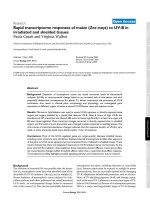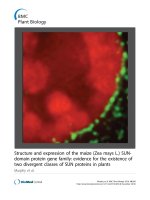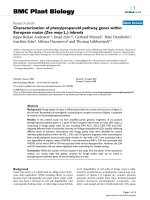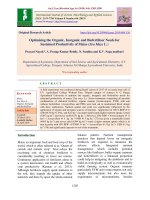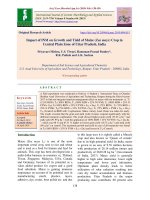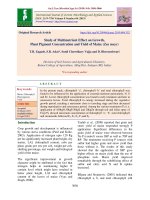Effect of tillage, sowing time and irrigation levels on nutrient uptake and yield of maize (Zea mays L.)
Bạn đang xem bản rút gọn của tài liệu. Xem và tải ngay bản đầy đủ của tài liệu tại đây (230.95 KB, 8 trang )
Int.J.Curr.Microbiol.App.Sci (2020) 9(3): 296-303
International Journal of Current Microbiology and Applied Sciences
ISSN: 2319-7706 Volume 9 Number 3 (2020)
Journal homepage:
Original Research Article
/>
Effect of Tillage, Sowing Time and Irrigation Levels on Nutrient Uptake
and Yield of Maize (Zea mays L.)
Archana Kumari1, Sanjay Kumar1, Mainak Ghosh1, Chandini1, Swaraj Kumar Dutta1,
Vinod Kumar1*, Amit Kumar Pradhan2 and Subrat Keshori Behera3
1
Department of Agronomy, Bihar Agricultural University, Sabour, Bihar 813210
Department of Soil Science and Agricultural Chemistry, BAU, Sabour, Bihar 813210
3
Department of Statistics Mathematics and Computer Application, BAU, Sabour, Bihar
813210, India
2
*Corresponding author
ABSTRACT
Keywords
Zero tillage, Date of
sowing, Maize
nutrient content,
Irrigation
Article Info
Accepted:
05 February 2020
Available Online:
10 March 2020
A field experiment was conducted during the rabi season of 2016-17at Research farm of
Bihar Agricultural College, Sabour, to evaluate the effect of tillage, sowing time and
irrigation levels on nutrient uptake and yield of maize (Zea mays L.).The experiment
comprised of two tillage methods viz. conventional tillage (CT) and zero tillage (ZT) in
main plot, two sowing dates- 30th October and 10th November as sub-plot and three
irrigation levels (I2 - 2 irrigations at six-leaf stage and tasseling, I4 - 4 irrigations at fourleaf stage, ten leaf stage, tasseling and milking and I6 - 6 irrigations at four-leaf stage, eight
leaf stage, ten leaf stage, tasseling, milking and dough stage) as sub-sub plot treatment.
The results indicated that the nutrient dynamics and productivity of rabi maize is
significantly influenced by management practices. The higher nutrient content was
recorded in CT maize stover and ZT maize grain and with 4 irrigations. However,
maximum nutrient uptake and grain yield (11.1 t ha -1) was recorded in ZT system with six
irrigation. Delay in sowing of rabi maize reduced the grain yield considerably at a rate of
121 kg/ha/day. With increasing resource as well as crop management constraints, adoption
of ZT along with residue retention and optimum water use has the potential of improving
the nutrient uptake, nutrient use efficiency and crop productivity.
accepted by farmers of Bihar with a cultivated
area of 0.28 million ha with total production
of 2.1 million tonnes (Directorate of
Economics & Statistics, 2018-19). To
augment the higher maize yield per unit area
and sufficient nutrient uptake, proper crop
agronomic management is necessary. Sowing
of the crop at right time ensures better plant
Introduction
In India, maize has been widely cultivated as
a rainfed crop during kharif season but it can
also be successfully grown during the rabi
season as yield of rabi maize is considerably
higher than that of kharif maize (Patel et al.,
2006). The rabi maize has been widely
296
Int.J.Curr.Microbiol.App.Sci (2020) 9(3): 296-303
growth, boosting the maize yield by
increasing the resource use efficiency and
also by inhibiting weed growth. Tillage
system is an integral part of crop production
and it has been confirmed by different
scientists that conventional intensive tillage
increases soil compaction, reduces soil
aggregates stability, disrupts soil productivity,
decreases retention and transportation of
water and solutes and exacerbates losses due
to run-off erosion (Goddard et al., 2008). In
contrast many beneficial effects of zero-till
and minimum tillage have also been reported
like increased porosity, organic carbon, water
holding capacity and decreased bulk density.
It is well documented that zero tillage and
crop residues management improves soil
health and quality by improving various soil
properties like reduced penetration resistance
as well as the apparent density of soil that
checks the soil evaporation rate (Rivas et al.,
1998). Water infiltration and soil aeration that
depend on bulk density are also modified
(Rice et al., 1987). Zero tillage affects water
availability to plants, essentially through soil
water capture and root uptake capacity (Gajri
et al., 1994; Ojeniyi, 1986). Zero tillage has
also been reported to increase total nitrogen
and microbial biomass in various soils
(McCarty et al., 1995). The crop residues in
zero tillage become a mulch over the soil
surface that protects the soil productive layer
against run-off reducing the nutrient loss and
erosion through runoff (Perret et al., 1999,
Smart and Bradford, 1999) and increases the
percentage of organic matter in the superficial
soil layer (Rivas et al., 1998; Roldan et al.,
2003). Irrigation is another important
management practice for higher crop
production with better nutrient uptake which
is mainly dependent on both irrigation
frequency and total water application
affecting root distribution and total root
length (Robertson et al., 1980). This
determines the vital plant physiological
processes like cell elongation, cell division,
cell wall synthesis, nitrate reductase activity
and photosynthesis that are very sensitive to
plant water status. Therefore, performance of
a plant in terms of its growth, yield and
nutrient content is mainly dependent on plant
water status. Availability of optimum
moisture in the soil enhances the efficiency of
applied nutrients, and any reduction of soil
moisture at these stages will considerably
reduce the grain yield. The present
investigation was carried out to evaluate the
effect of tillage, sowing time and irrigation
levels on nutrient concentration and uptake by
maize and crop productivity.
Materials and Methods
A field experiment was conducted during the
rabi season of 2016-17 at Bihar Agricultural
University farm, Sabour (25o15′40″ N,
87o2′42″ E; 37 m above mean sea level),
Bhagalpur, Bihar, India. The soil of the
experimental field was sandy loam with
neutral in reaction, medium in organic carbon
(0.6%) and available phosphorus (35.2 kg
P2O5 ha-1), while low in available soil
nitrogen (220.1 kg ha-1), and rich in soil
potassium (327 kg K2O ha-1). The experiment
comprised of twelve treatment combinations
laid out in split-split design with three
replications. The two tillage methods viz. zero
tillage (T1 - ZT) and conventional tillage (T2 CT) were kept as main plots, while in sub-plot
it was two sowing dates (D1 - 30 October and
D2 - 10 November), and in sub-sub plot there
were three irrigation levels i.e. I2 (2 irrigations
at six-leaf stage and tasseling), I4 (4
irrigations at four-leaf stage, ten leaf stage,
tasseling and milking) and I6(6 irrigations at
four-leaf stage, eight leaf stage, ten leaf stage,
tasseling, milking and dough stage). All the
treatments received half nitrogen along with
full dose of phosphorus and potassium as
basal while the remaining N was top-dressed
in two equal splits at knee-high and tasseling
stage. The recommended dose of N:P2O5:K2O
297
Int.J.Curr.Microbiol.App.Sci (2020) 9(3): 296-303
for maize crop was kept as 150:75:50 kg ha-1.
The maize crop was sown on 30 October and
10 November in the year 2016 with a spacing
of 60×20 cm and harvested on 7 April and20
April 2017, respectively. The plant samples
for NPK analysis were collected at harvest
stage. The Nitrogen content in dry matter was
analysed by using micro-kjeldahl method
(Tandon, 1993), phosphorus content by
vanadomolybadate phosphoric acid yellow
colour method (Jackson, 1973) and potassium
content by flame photometer (Jackson,
1973).The N, P and K uptake were computed
by multiplying nutrient content of grain and
straw with respective dry weight (kg ha-1) at
harvest stage. Grain and stover yield in each
net plot was weighed and expressed in
kg ha-1. The experimental data recorded were
analyzed statistically in split-split plot design
to test the significance of the overall
differences among treatments by using the F
test and conclusions were drawn at 5%
probability level.
nitrogen content of stover recorded higher
value with I4 (0.63%) which was found to be
at par with I6 (0.62 %) and significantly
higher than I2(0.59%) whereas grain nitrogen
content was significantly higher with I6
(1.60%) followed by I4 (1.54 %) and I2 (1.44
%) irrigation levels respectively. The
phosphorus content of stover was recorded
higher with I6 (0.28%) followed by I4 (0.25 %)
and I2 (0.22%) whereas for grain phosphorus
content was recorded higher with I6 (0.33%)
followed by I4 (0.28 %) and I2 (0.28 %). The
data of the potassium content of stover and
grain was influenced only by different
irrigation levels in sub-sub plot treatment. For
stover, it was recorded higher with I6 (1.20%)
which was at par with I4 (1.19 %) and
significantly higher over I2 (1.13 %)
respectively. In grain, the potassium content
followed a similar trend with higher values
being recorded under I6 (0.69%) followed by
I4 (0.67 %) and I2 (0.64 %) respectively. The
N, P and K content of maize grain and stover
was significantly influenced due to tillage and
irrigation levels. The maximum value of N, P
and K content was recorded under ZT with
the highest level of irrigation applied with six
irrigations. This could be attributed to the fact
that ZT provided better soil environment for
improved root development and also higher
irrigation level ensured minimum water stress
and also nutrient availability with increased
forage area by the roots for nutrient extraction
(Yadav et al., 2016). A similar pattern of
nutrient content in maize crop under zerotillage based conservation agriculture
practices have also been reported by other
researchers (Alam et al., 2014; Naresh et al.,
2014).
Results and Discussion
Nitrogen, phosphorus and potassium
concentration in stover and grain of maize
as influenced by differenttreatments
Results revealed that nitrogen content in both
stover and grain was significantly affected by
tillage practices and irrigation levels (table1).
Conventional
tillage
(CT)
recorded
significantly higher values of nitrogen
(0.63%) and phosphorus content (0.28%) in
stover respectively. Grain nitrogen content
recorded higher value with zero tillage (ZT)
(0.55%) whereas grain phosphorus content
remained unaffected. On the contrary, date of
sowing significantly affected only the
phosphorous content in grain and the
maximum phosphorus content for grain was
recorded with D2 sowing (0.31 %) which was
significantly higher than D1 sowing (0.29%).
In sub-sub plot, due to irrigation levels,
Total nitrogen, phosphorus and potassium
uptake of maize as influenced by different
treatments
The data recorded on the total uptake of
nitrogen (N), phosphorus (P) and potassium
298
Int.J.Curr.Microbiol.App.Sci (2020) 9(3): 296-303
grain yield under ZT (9164.9 kg ha-1) as
compared to CT (8043.2 kg ha-1) which was
14 per cent more over CT. In sub-plot due to
date of sowing, grain yield was significantly
higher when sown on D1-30th October (9270.6
kg ha-1) than D2-10th November (7937.4 kg
ha-1) sowing. Due to the early sowing of
maize the yield was higher by 17 per cent and
the yield decreased at a rate of 121 kg/ha/day
over early sown crop. In sub-sub plot
significantly higher, grain yield was recorded
with I6 (11077.4 kg ha-1) which was
significantly higher over I4 (9565.5 kg ha-1)
and I2 (5169.1 kg ha-1) irrigation levels. The
significant yield increase with four irrigations
(I4) over I2 was 85 per cent while a further
increase of two irrigations under I6, a 16 per
cent increase in yield was recorded over I4
irrigation level. From the results, it can be
concluded that zero tillage had a significant
influence in increasing the crop yield
followed by sowing time and irrigation levels.
ZT in combination with earlier sowing and six
irrigations produced the maximum yield.
However, ZT of the early sown crop with four
irrigations could also produce equivalent yield
to that of CT plots under D1 sowing receiving
six irrigations and also ZT with late sowing
receiving six irrigations. The stone yield of
maize did not vary significantly due to tillage
methods or date of sowing. Due to irrigation
application, the stone yield recorded higher
values with I6 (six irrigations) (2920 kg ha-1)
which was statistically at par with I4 (four
irrigations) (2635.2 kg ha-1) and significantly
higher over I2 (two irrigations) (1580.8
kg ha-1). The higher yield of maize in ZT
plots could be attributed to the multiple
effects of nutrients added (Blanco-Canqui et
al., 2009 and Kaschuk et al., 2010),
comparatively lower weed pressure due to
maintenance of surface residue (Ozpinar,
2015 and Chauhan et al., 2007), better water
regimes promoting root growth and
development (Govaerts et al., 2009)
compared to CT.
(K) has been presented in table 2. The data
revealed that tillage practices significantly
influenced the higher nitrogen uptake with
zero tillage -T2 (203.6 kg ha-1) over
conventional tillage - T1(183.3 kg ha-1)
compared to the other nutrients like
phosphorus and potassium. Unlike tillage, the
difference in date of sowing only significantly
influenced the nitrogen uptake by the crop.
Due to tillage, the maximum total nitrogen
uptake was recorded with D1 sowing (202.1
kg ha-1) which was significantly higher over
D2 sowing (184.9 kg ha-1). However,
difference in irrigation application led to
significant variation in N, P and K uptake by
the crop. In sub-subplot due to irrigation,
maximum N, P and K uptake of 240, 69 and
146 kg ha-1 was recorded with I6 (six
irrigations) which was significantly higher
over I4 and I2irrigation levels respectively.
However, tillage and time of crop
establishment influence the nature of water
utilization by the crop and therefore water
productivity. Parihar et al., (2017) observed
that the maize growth parameters were
significantly (p<0.05) superior under zero
tillage and permanent bed compared to
conventional tillage. Yadav et al., (2016)
reported that ZT provided better soil
environment for improved root development
and also higher irrigation level ensured
minimum water stress and also nutrient
availability with increased forage area by the
roots for nutrient extraction.
Stover, grain and stone yield of maize as
influenced by different tillage methods,
date of sowing and irrigation levels
The data on the yield of maize crop has been
presented in table 3. The data revealed that
there was no significant difference in stover
yield of maize due to individual effect of
tillage, date of sowing and irrigation levels.
However, grain yield differed significantly
with tillage and recorded significantly higher
299
Int.J.Curr.Microbiol.App.Sci (2020) 9(3): 296-303
Table.1 Nitrogen, phosphorus and potassium concentration in stover and grain of maize as
influenced by different tillage methods, date of sowing and irrigation levels
Phosphorus content (%)
Potassium content (%)
Stover
Grain
Stover
Grain
Tillage
1.51
0.30
1.19
0.68
T1
0.63
0.28
0.60
0.22
0.29
1.16
0.66
T2
1.55
SEm (±)
0.00
0.00
0.00
0.01
0.00
0.01
LSD (0.05)
0.02
0.03
0.03
NS
NS
NS
Date of sowing
0.61
1.52
0.25
0.29
1.17
0.66
D1
0.62
1.54
0.25
1.18
0.67
D2
0.31
SEm (±)
0.01
0.02
0.00
0.00
0.00
0.01
LSD (0.05)
NS
NS
NS
0.01
NS
NS
Irrigation
0.59
1.44
0.22
0.28
1.13
0.64
I2
1.54
0.25
0.28
1.19
0.67
I4
0.63
0.62
I6
1.60
0.28
0.33
1.20
0.69
SEm (±)
0.01
0.02
0.01
0.01
0.01
0.01
LSD (0.05)
0.02
0.07
0.03
0.02
0.03
0.02
T1=Conventional Tillage; T2-Zero Tillage; D1=30th October;D2-10th November; I2=Irrigation at V6 and tasseling; I4Irrigation at V4, V10,tasseling, milking; I6-Irrigation at V4, V8, V10,tasseling, milking, dough stage of the crop
Treatment
Nitrogen content (%)
Stover
Grain
Table.2 Total nitrogen, phosphorus and potassium uptake of maize as influenced by different
tillage methods, date of sowing and irrigation levels
Treatment
T1
T2
SEm (±)
LSD (0.05)
D1
D2
SEm (±)
LSD (0.05)
I2
I4
I6
SEm (±)
LSD (0.05)
Total N uptake (kg ha-1) Total P uptake (kg ha-1) Total K uptake (kg ha-1)
Tillage
183.3
52.9
119.3
57.0
127.3
203.6
1.1
1.8
3.0
6.6
NS
NS
Date of sowing
55.0
125.9
202.1
184.9
54.9
120.7
1.3
1.0
2.0
5.3
NS
NS
Irrigation
126.7
39.5
89.4
213.7
56.6
134.8
240.0
68.7
145.6
3.1
1.3
1.7
9.4
3.9
5.2
300
Int.J.Curr.Microbiol.App.Sci (2020) 9(3): 296-303
Table.3 Yield of maize as influenced by different tillage methods, date of sowing and irrigation
levels
Treatment
Stover yield (kg ha-1)
T1
T2
SEm (±)
LSD(0.05)
7403.4
7412.0
398.2
NS
D1
D2
SEm (±)
LSD(0.05)
7165.7
7649.7
394.2
NS
I2
I4
I6
SEm (±)
LSD(0.05)
7183.4
7820.7
7218.9
292.0
NS
Grain yield (kg ha-1)
Stone yield (kg ha-1)
Tillage
8043.2
9164.9
55.4
336.9
Date of sowing
9270.6
7937.4
154.9
608.3
Irrigation
5169.1
9565.5
11077.4
101.5
304.3
2107.2
2650.1
105.6
NS
2499.4
2257.8
65.5
NS
1580.8
2635.2
2919.9
101.3
303.6
T1=Conventional Tillage; T2-Zero Tillage; D1=30 October;D2-10 November; I2=Irrigation at V6 and tasseling; I4Irrigation at V4, V10,tasseling, milking; I6-Irrigation at V4, V8, V10,tasseling, milking, dough stage of the crop
The findings of higher maize yield under ZT
in close agreement with the findings of Yadav
et al., (2016), Gathala et al., (2013), Parihar et
al., (2016). The higher yield of maize under
zero tillage system could be attributed to the
compound effect of early establishment of the
crop due to favorable moisture conditions in
soil, additional nutrients (Blanco-Canqui et
al., 2009 and Kaschuk et al., 2010), reduced
competition for resources and improved biophysicochemical soil health as observed by
previous researchers (Jat et al., 2013 and
Govaerts et al., 2009) over conventional
tillage system.
zero tillage system also has the potential to
produce similar or higher grain yield
compared to early sown maize with six
irrigations under conventional tillage. This
higher yield and nutrient uptake in ZT plots
could be attributed to the multiple effects of
added nutrient and organic matter,
comparatively lower weed pressure due to
maintenance of surface residue, better water
regimes promoting root growth and
development compared to CT. Nutrient
uptake was recorded highest with early
sowing of maize with 6 irrigations under ZT
system. Early sowing ensures better crop
establishment and ZT with higher irrigation
level provides better bio-physicochemical soil
health for improved root development
ensuring better nutrient extraction with
increased forage area.
In conclusion, zero tillage was found to be an
advantageous tillage practice in improving
soil environment, facilitating maximum crop
production while maintaining the soil health.
In this experiment the zero tillage in
combination with earlier sowing and six
irrigations produced the maximum yield.
Other interaction effect again confirmed that
early sown maize with 4 irrigations under
References
Alam
301
MK, Islam MM, Salahin N,
Hasanuzzaman M (2014). Effect of
Int.J.Curr.Microbiol.App.Sci (2020) 9(3): 296-303
tillage practices on soil properties and
crop productivity in wheat-mungbeanrice cropping system under subtropical
climatic conditions. Scientific World
Journal, 10: 40–55.
Blanco-Canqui H, Lal R (2009). Crop residue
removal impacts on soil productivity
and environmental quality. CRC Crit.
Rev. Plant Sci., 28:139–63.
Chauhan BS, Gill GS, Preston C (2007).
Effect of seeding systems and
dinitroaniline herbicides on emergence
and control of rigid ryegrass (Lolium
rigidum) in wheat. Weed Technol., 21:
53–8.
Directorate of Economics & Statistics, 201819.
Gajri PR, Arora VK and Chaudhary MR
(1994). Maize growth response to deep
tillage, straw mulching and farmyard
manure in coarse textured soils of NW
India. Soil Use Manage. 10, 15–20.
Gathala MK, Kumar V, Sharma PC,
Saharawat YS, Jat MS, Singh M,
Kumar A, Jat ML (2007). Emergence
and control of rigid ryegrass (Lolium
rigidum) in wheat. Weed Technology,
21: 53–8.
Goddard T, Zoebisch M, Gaa, Ellis and
WatlonAS(2008). No tillage farming
system, world association on soil and
water conservation. 39: 1
Govaerts B, Sayre KD, Goudeseune B, De
Corte P, Lichter K, Dendooven L,
Deckers J (2009). Conservation
agriculture as a sustainable option for
the central Mexican highlands. Soil and
Tillage Research, 103: 222–30.
Jackson ML (1973). Soil Chemical Analysis,
Vol.4 Prentice Hall of India Private
Limited, New Delhi.
Jat SL, Parrihar CM, Sing AK, Jat ML, Jat
RK (2014). Abstracts of 12th Asian
Conference and Expert Consultation on
Maize for Food, Feed, Nutrition and
Environment.
Kaschuk G, Alberton O, Hungria M (2010).
Three decades of soil microbial biomass
studies in Brazilian ecosystems: lessons
learned about soil quality and
indications for improving sustainability.
Soil Biol Biochem., 42:1–13.
McCarthy GW, Meisinger JJ and Jenniskens
MM (1995). Relationship between totalN, biomass-N and active-N in soil under
different tillage and N fertilizer
treatments. Soil Biol. Biochem. 27,
1245–1250.
Naresh RK, Rathore RS, Kumar P, Singh SP,
Singh A and Shahi UP (2014). The
Indian Journal of Agricultural Sciences,
84(6), 105-109.
Ojeniyi SO (1986). Effects of zero-tillage and
disk plowing on soil water, soil
temperature and growth and yield of
maize (Zea mays L.). Soil Tillage Res.
7, 173–182.
Ozpinar S (2015). Nutrient concentration and
yield of maize (Zea mays L.) after vetch
(Vicia sativa L.) in conventional and
reduced tillage systems. Journal of
Plant Nutrition, 39(12): 1697-1712.
Parihar CM, Jat SL, Singh AK, Kumar B,
Yadvinder-Singh, Pradhan S, Pooniya
V, Dhauja A, Chaudhary V, Jat ML, Jat
RK and Yadav OP (2016). Conservation
agriculture in irrigated intensive maizebased systems of north-western India:
Effects on crop yields, water
productivity and economic profitability.
Field Crops Res, 193:104–16.
Parihar CM, Jat SL, Singh AK, Majumdar K,
Jat ML, Saharawat YS, Pradhan S and
Kuri BR (2017). Bio-energy, biomass
water-use efficiency and economics of
maize-wheat-mungbean system under
precision-conservation agriculture in
semi-arid agroecosystem, Energy, 119:
245-56.
Patel JB, Patel VJ and Patel JR (2006).
Influence of different methods of
irrigation and nitrogen levels on crop
302
Int.J.Curr.Microbiol.App.Sci (2020) 9(3): 296-303
growth rate and yield of maize (Zea
mays L.). Indian Journal of Crop
Sciences. 1 (1&2): 175-177.
Perret S, Michellon R and Tassin J (1999).
Agroecological practices as tools for
sustainable management of erosion of
exposed
tropical
catchments:
quantifying their effects on soil
restoration and erosion control in
Reunion island (Indian Ocean French
Overseas Territories). In Sustainable
Management of Tropical Catchment.
Ed. D M T Herper Brown, Wiley,
London; pp. 400.
Prasanna AL, Bairagya MD, Devi TM,
Zaman AU (2019). Effects of Irrigation
Regime and Nitrogen Level on Yield
and Yield Attributes of Summer Maize
(Zea mays L.). Int. J. Curr. Microbiol.
App. Sci., 8(7):727-33.
Radford BJ, Dry AJ, Robertson LN and
Thomas BA (1995). Conservation
tillage increases soil water storage, soil
animal populations, grain yield and
response to fertilizer in the semiarid
sub-tropics. Aust. J. Exp. Agric. 35,
223–232.
Rice CW, Grove HJ and Smith MS (1987).
Estimating
soil
net
nitrogen
mineralization as affected by tillage and
soil drainage due to topographic
position. Can. J. Soil. Sci. 67, 513–520.
Rivas E, Rodriguez M and Manrique U
(1998). Effecto de la labranza sobre las
propriedades fisicas y quimicas del
suelo y el rendimiento de maiz en los
llanos altos del estado Monagas. Agron.
Trop. 48, 157–174.
Robertson WK, Hammond LC, Johnson JT,
and Boote KJ (1980). Effects of plantwater stress on root distribution of corn,
soybeans, and peanuts in sandy soil.
Agron. J., 72, 548-550.
Smart JR and Bradford JM (1999).
Conservation tillage corn production for
a semi-arid, subtropical environment.
Agron. J. 91, 116–121.
Tandon HLS (1993). Methods of Analysis of
soil, plant, water and fertilizers.
Fertilizer Development and consultation
organization, New Delhi.
Yadav MR, Parihar CM, Jat SL, Singh AK,
Kumar, D, Pooniya V, Parihar MD,
Saveipune D, Parmar H and Jat ML
(2016). Effect of long-term tillage and
diversified crop rotations on nutrient
uptake, profitability and energetics of
maize (Zea mays) in north-western
India. Indian Journal of Agricultural
Sciences, 86(6): 743–9.
How to cite this article:
Archana Kumari, Sanjay Kumar, Mainak Ghosh, Chandini, Swaraj Kumar Dutta, Vinod
Kumar, Amit Kumar Pradhan and Subrat Keshori Behera. 2020. Effect of Tillage, Sowing
Time and Irrigation Levels on Nutrient Uptake and Yield of Maize (Zea mays L.).
Int.J.Curr.Microbiol.App.Sci. 9(03): 296-303. doi: />
303

